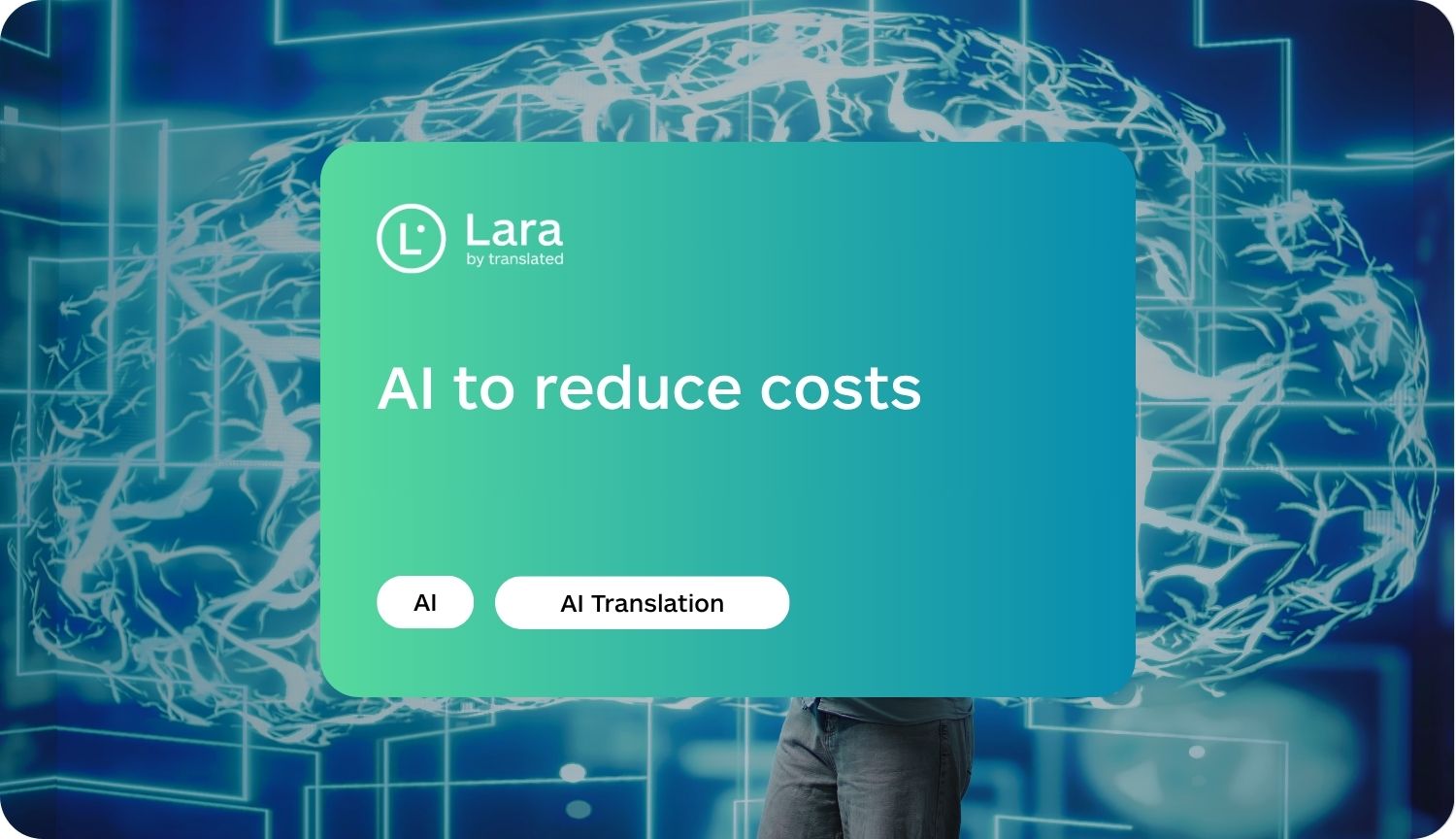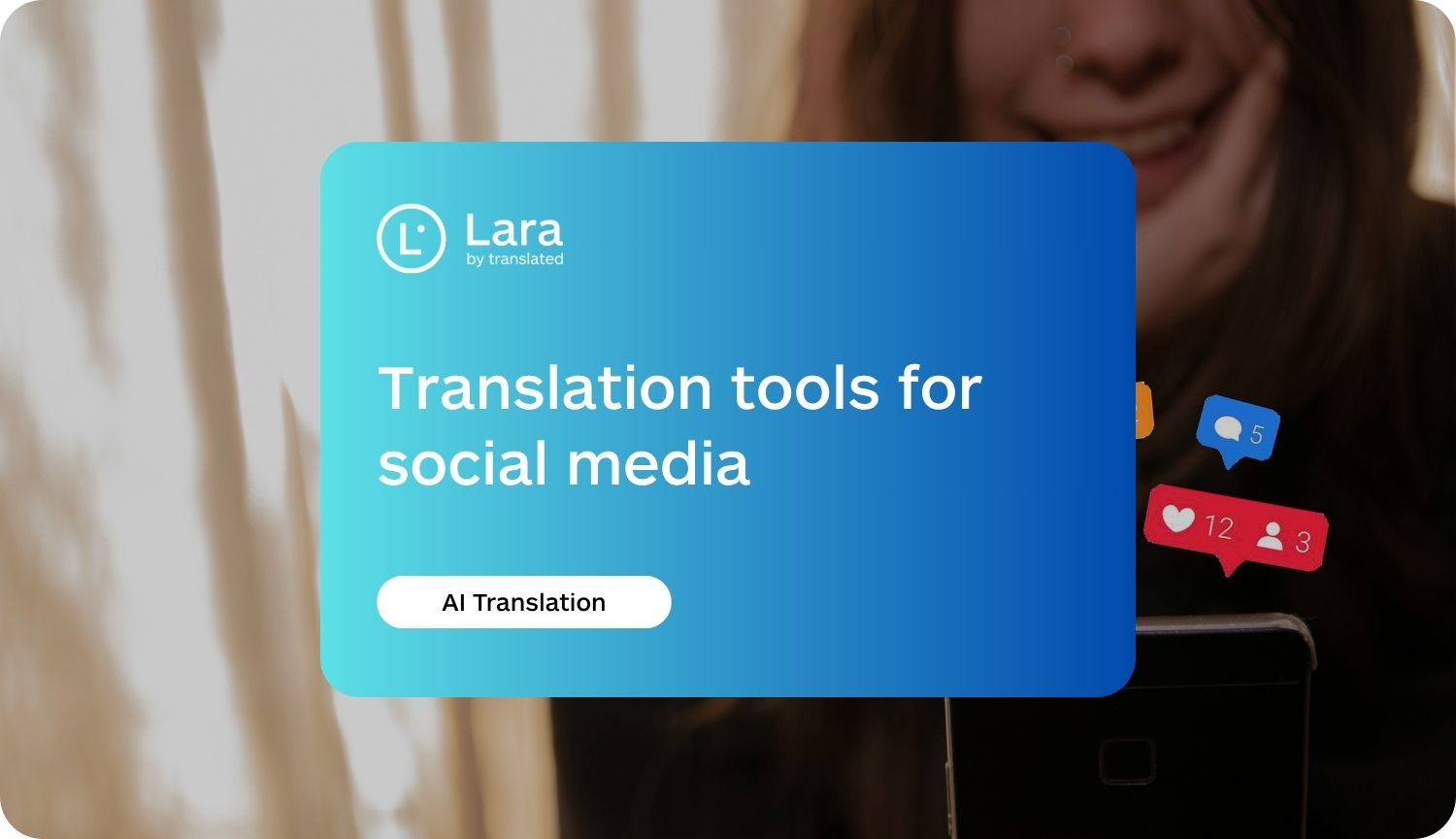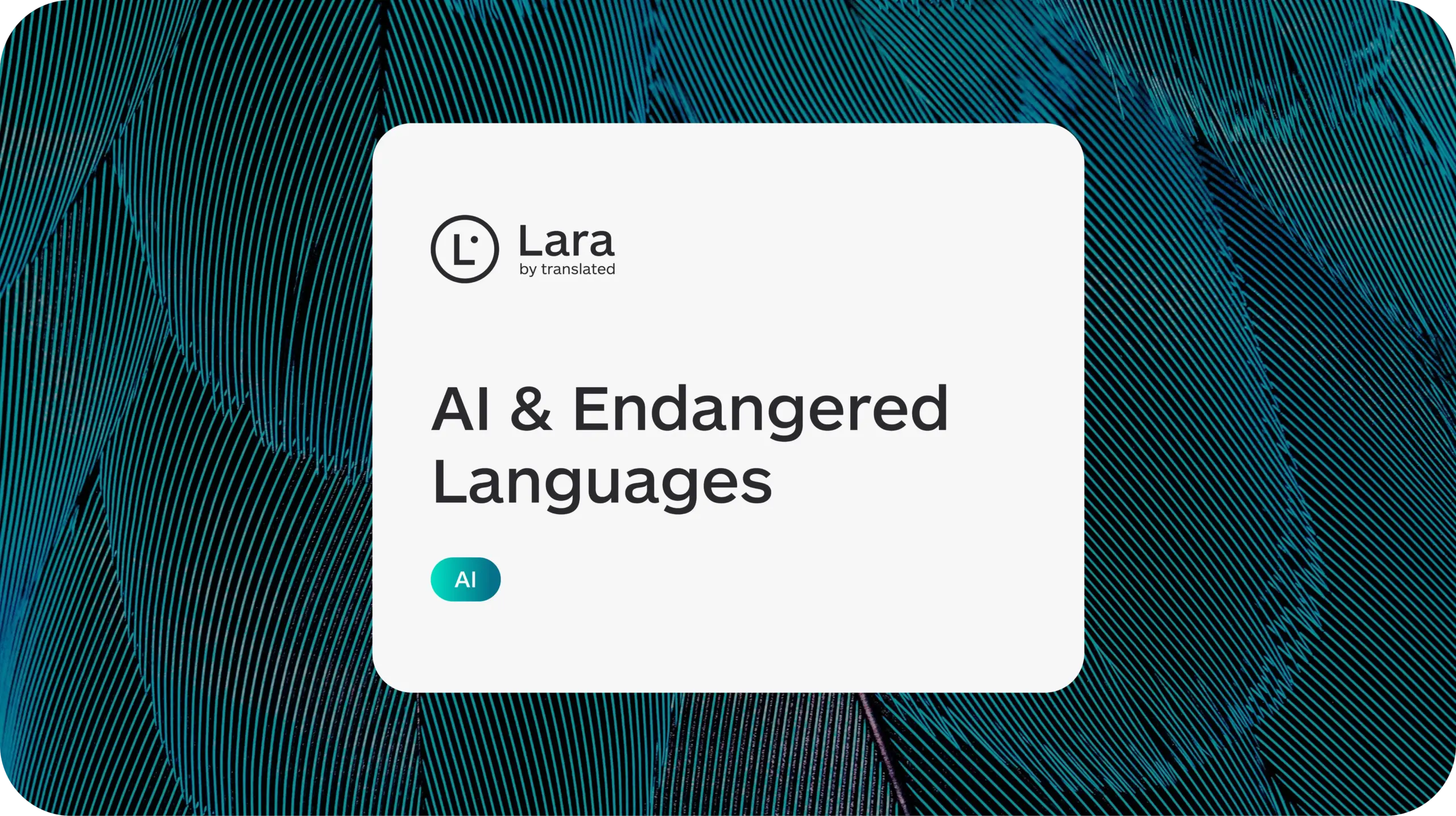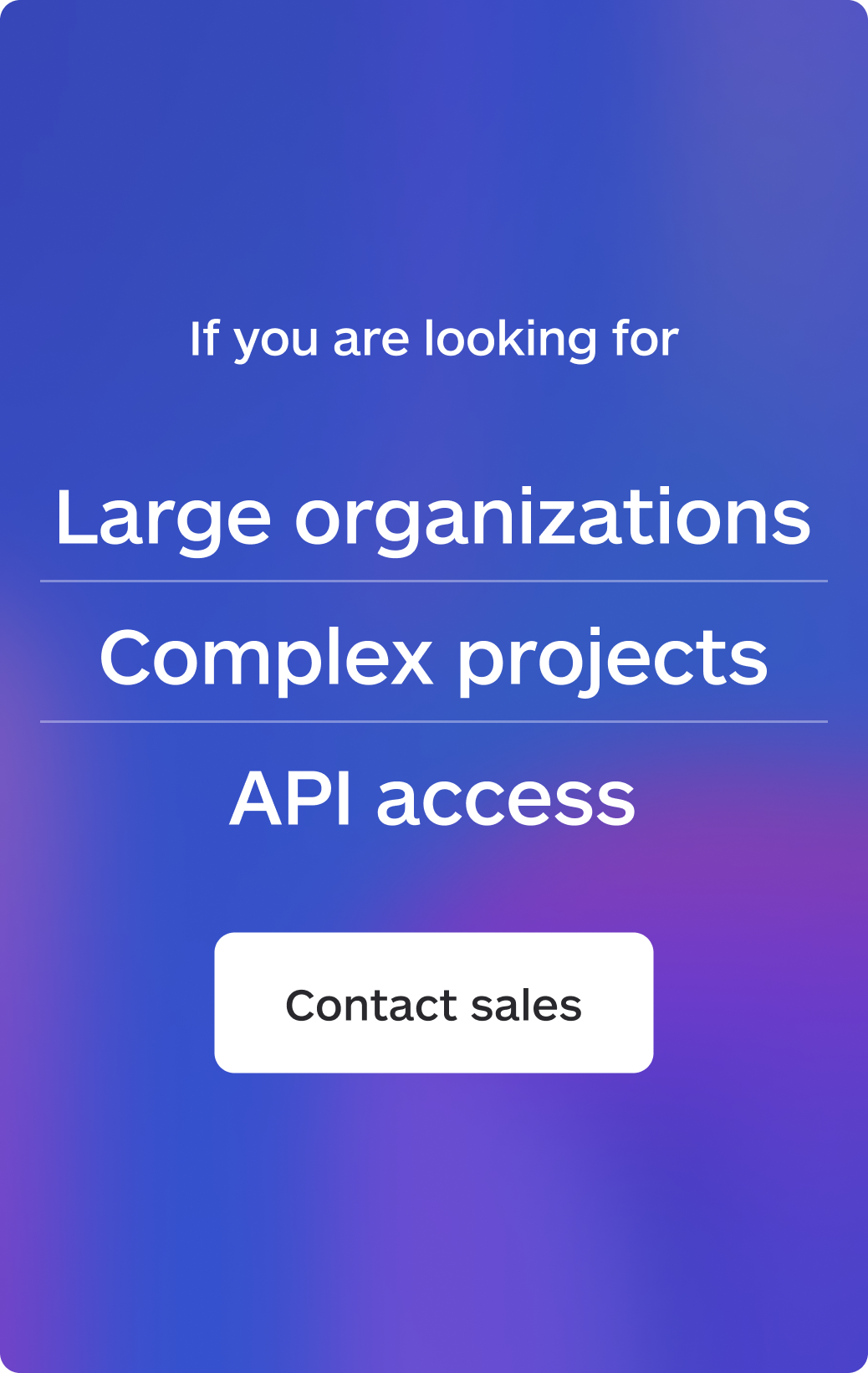You’ve just walked out of a management meeting, and your boss has handed you what feels like both an exciting opportunity and a huge challenge:
We need to integrate AI into our workflows to cut operational costs. I want you to lead the charge.

But where do you start yo integrate AI in a company that may have established procedures and teams who might be hesitant about technological change? This guide will walk you through practical steps to begin your AI implementation roadmap, focusing particularly on one of the most accessible and immediately beneficial applications: AI-powered translation.
Understanding the business case for AI integration
Before diving into tools and technologies, it’s essential to understand why AI for operational cost reduction makes sense for your organization. The most successful AI initiatives begin with clear business objectives rather than implementing technology for its own sake.
AI can transform business operations in numerous ways:
- Automating repetitive, time-consuming tasks
- Improving decision-making through data analysis
- Enhancing customer experiences through personalization
- Breaking down language barriers to facilitate global operations
- Reducing human error in complex processes
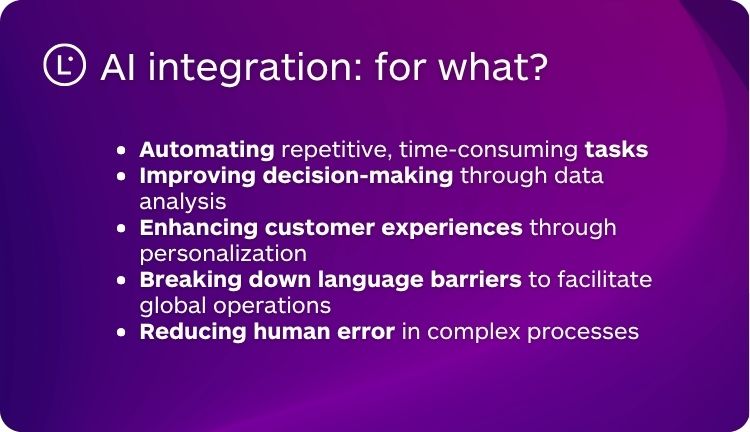
According to recent surveys, companies that integrate AI solutions have reported cost reductions of 60-90% compared to traditional methods in areas like translation and document processing. Additionally, the efficiency gains often lead to faster time-to-market and improved employee satisfaction as team members can focus on more creative and strategic work.
Identifying the right entry point for your AI journey
Not all AI implementations need to be enterprise-wide transformations. In fact, starting with a focused application in one department or process often leads to more immediate ROI and valuable lessons for broader AI adoption strategies.
Translation and localization represent an ideal starting point for many organizations due to their:
- Clear business value (expanding market reach and improving global operations)
- Measurable outcomes (time and cost savings compared to traditional translation)
- Minimal disruption to existing workflows
- Relatively low implementation barriers
For companies with international operations or aspirations, AI translation tools can immediately impact the bottom line while providing a solid foundation for future AI initiatives.
How to choose AI tools for your company
Selecting the right AI solution requires considering your specific business needs, technical requirements, and budget constraints. When evaluating enterprise AI tools, consider these key factors:
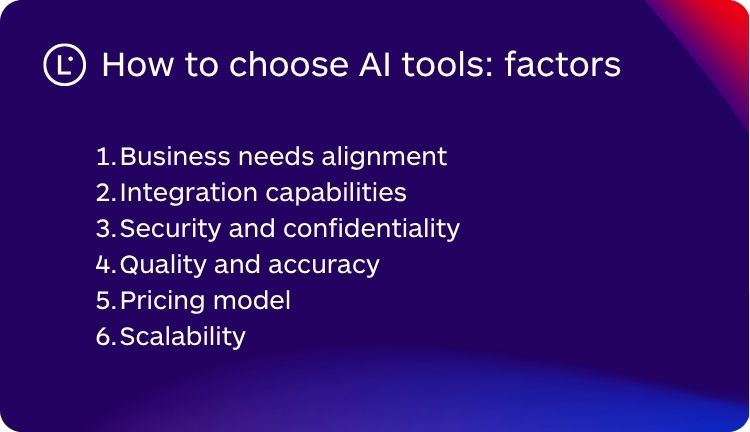
- Business needs alignment Ensure the solution addresses specific pain points in your current workflows. For translation, this might include the types of content you need to translate (technical documentation, marketing materials, internal communications) and the languages you require.
- Integration capabilities The best scalable AI solutions will seamlessly connect with your existing tech stack—whether that’s your content management system, communication platforms, or document storage solutions.
- Security and confidentiality Particularly important for translation, where sensitive business information may be processed. Ensure the solution offers appropriate data protection measures.
- Quality and accuracy Test the solution with representative content to ensure it meets your quality standards.
- Pricing model Consider whether a subscription-based, pay-per-use, or enterprise licensing model works best for your organization’s needs.
- Scalability Choose solutions that can grow with your business needs, supporting additional workflows, languages, or volume as your AI initiatives expand.
Implementing Lara Translate as your AI translation solution
When looking for an AI translation tool that meets enterprise requirements while offering ease of implementation, Lara Translate stands out as a particularly powerful option.
Lara Translate leverages advanced AI technology specifically designed for professional translation needs. Unlike general-purpose language models, Lara’s specialized Translation Language Models are optimized for business contexts, offering superior accuracy for professional content.
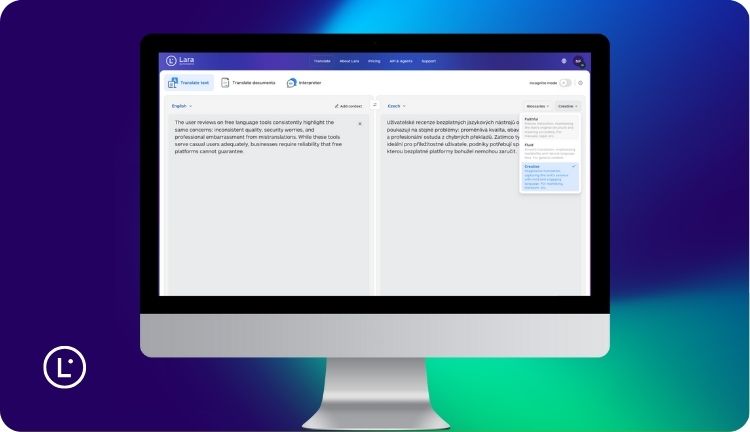
What sets Lara Translate apart is its implementation of the Model Context Protocol (MCP), which allows for more context-aware translations that maintain brand voice, technical terminology, and stylistic elements. This makes it ideal for businesses requiring consistent, high-quality translations across multiple types of content and languages.
Lara Translate supports so many languages, providing excellent coverage for global businesses. It offers both a user-friendly interface for direct use and robust API options for seamless integration with existing workflows and systems.
Creating your AI implementation roadmap
Once you’ve identified AI translation as your entry point and selected a solution like Lara Translate, it’s time to create a structured implementation plan. A well-designed AI automation strategy increases your chances of success and maximizes ROI.

Phase 1: Preparation and planning
- Define clear objectives: Document specific goals such as reducing translation costs by X%, decreasing turnaround time, or expanding into new markets.
- Identify stakeholders: Include representatives from departments that will use translations (marketing, product, customer support) as well as IT for technical integration.
- Conduct a content audit: Catalog what needs translation, prioritizing high-value content.
- Set baseline metrics: Document current translation costs, timeframes, and quality benchmarks to measure improvement.
Phase 2: Pilot implementation
- Start small: Select a single content type or department for your pilot.
- Develop translation resources: Create glossaries and style guides to ensure consistency.
- Train key users: Ensure team members understand how to use the AI translation tool effectively.
- Establish a quality assurance process: Determine how translations will be reviewed and refined.
Phase 3: Evaluation and optimization
- Measure results: Compare actual outcomes to your baseline metrics.
- Gather user feedback: Learn from team members’ experiences with the new workflow.
- Refine processes: Adjust based on lessons learned during the pilot.
- Document best practices: Create guidelines for future expansion.
Phase 4: Scaling and integration
- Expand to additional content types: Gradually incorporate more translation needs.
- Integrate with more systems: Connect with additional business applications.
- Automate workflows: Reduce manual steps in the translation process.
- Cross-functional training: Broaden the user base across departments.
Cost-saving AI use cases in translation workflows
To better understand the tangible benefits, let’s explore specific AI cost optimization examples across different business functions:
Marketing teams can use AI translation to:
- Localize marketing campaigns for international markets without extensive manual translation
- Create multilingual social media content in minutes rather than days
- Ensure consistent brand messaging across languages
- Test new markets with minimal investment
Customer support can leverage AI translation to:
- Offer multilingual support without hiring language specialists
- Translate knowledge base articles and FAQs automatically
- Enable agents to communicate with customers in their preferred language
- Improve response times for international inquiries
Product development can benefit from:
- Faster localization of user interfaces and documentation
- More efficient collection of international user feedback
- Simplified collaboration with global development teams
- Quicker time-to-market for international product releases
Internal communications can improve through:
- Multilingual company announcements and policies
- Translation of training materials for global teams
- More inclusive meetings with real-time translation
- Breaking down language barriers between international offices
Getting leadership buy-in for AI implementation
Even with a clear AI business transformation vision, securing executive support is critical for sustainable implementation. Here’s how to build a compelling case:
Focus on business outcomes, not technology: Frame AI translation in terms of market expansion, customer satisfaction, and operational efficiency—not just as a new tool.
Present concrete ROI projections: Detail the expected cost savings compared to traditional translation methods. Include both direct cost reductions and productivity gains.
Address potential concerns proactively: Be prepared to discuss data security, integration requirements, and change management.
Suggest a phased approach: Propose starting with a limited pilot to demonstrate value before wider implementation.
Share competitor insights: Research how similar companies are leveraging AI translation to remain competitive in global markets.
AI integration tips for SMBs
Small and medium-sized businesses face unique challenges when integrating AI in business workflows, but they can also be more agile in adoption. If you’re implementing AI translation in an SMB environment:
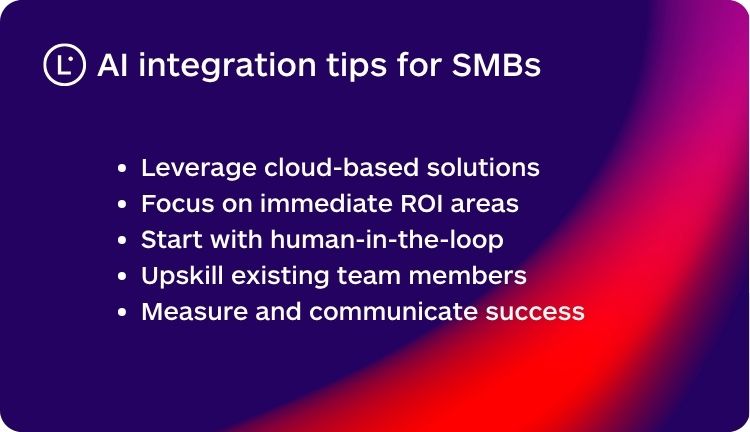
Leverage cloud-based solutions: Avoid heavy infrastructure investments by choosing SaaS translation platforms that scale with your needs.
Focus on immediate ROI areas: Target your initial implementation on high-value content that directly impacts revenue or customer experience.
Start with human-in-the-loop: Begin with a hybrid approach where AI provides the first draft but humans review and refine the output to ensure quality.
Upskill existing team members: Rather than hiring specialists, train current employees to effectively use AI translation tools.
Measure and communicate success: Track and share wins to build momentum for further AI adoption.
Balancing AI and human expertise in translation
While AI translation offers impressive benefits, it’s important to recognize that AI for internal processes works best when complemented by human expertise. Professional translators bring cultural nuance, contextual understanding, and creative adaptation that AI alone cannot match.
The most effective approach is often a collaborative one, where AI handles the initial translation work—dramatically improving efficiency and reducing costs—while human experts focus on review, refinement, and cultural adaptation.
This balanced approach is particularly important for:
- Marketing and creative content where cultural nuance matters
- Legal documents requiring precise interpretation
- Content with industry-specific terminology
- High-stakes communications where errors could be costly
By respecting the complementary roles of AI and human expertise, you can maximize cost savings while maintaining quality and appropriateness across all your translated content.
Starting your AI journey with translation
Integrating AI in business workflows doesn’t have to be overwhelming. By starting with a focused application like AI translation, you can achieve immediate benefits while building the foundation for broader AI adoption.
The key is to approach implementation strategically:
- Define clear business objectives tied to cost reduction and efficiency
- Select the right AI translation tool that meets your specific needs
- Start with a limited pilot to demonstrate value
- Refine processes based on early learnings
- Scale gradually across more content types and departments
- Maintain a balance between AI efficiency and human expertise
By following this roadmap, you’ll not only successfully address your boss’s request to leverage AI for cost reduction but potentially position yourself as an innovation leader within your organization.
Remember that successful AI implementation is less about the technology itself and more about how effectively it solves real business problems and enhances human capabilities. With a thoughtful approach to AI-powered translation, you’re taking a significant first step toward broader digital transformation.
FAQ
How much can we realistically save by implementing AI translation?
Most businesses report cost reductions of 60-90% compared to traditional translation services, depending on content volume and language pairs. Time savings are often even more significant, with translation times reduced from days to minutes.
Will our content be secure when using AI translation tools?
Enterprise-grade AI translation platforms like Lara Translate offer robust security measures, including data encryption and confidentiality agreements. When evaluating tools, prioritize those with clear data privacy policies and security certifications.
How can we ensure quality when using AI translation?
Implement a multi-layered approach: use specialized translation AI (not general-purpose AI), provide context and glossaries to the system, and establish a human review process for important content. The quality of AI translation has improved dramatically in recent years but benefits from human oversight for critical materials.
What skills do our team members need to effectively use AI translation?
Most modern AI translation tools are designed to be user-friendly. Basic digital literacy is usually sufficient for day-to-day use. For more advanced integration and workflow optimization, some technical knowledge may be helpful but is often not required.
How long does it take to implement an AI translation solution?
Basic implementation can be completed in days or weeks, depending on the complexity of your requirements and existing systems. A phased approach allows you to start seeing benefits quickly while building toward more comprehensive integration.
This article is about:
- How to integrate AI into business workflows to reduce operational costs
- Creating a balanced AI implementation strategy with minimal disruption
- Real-world AI use cases that deliver immediate ROI
- Gaining leadership support for successful AI adoption
Useful articles
